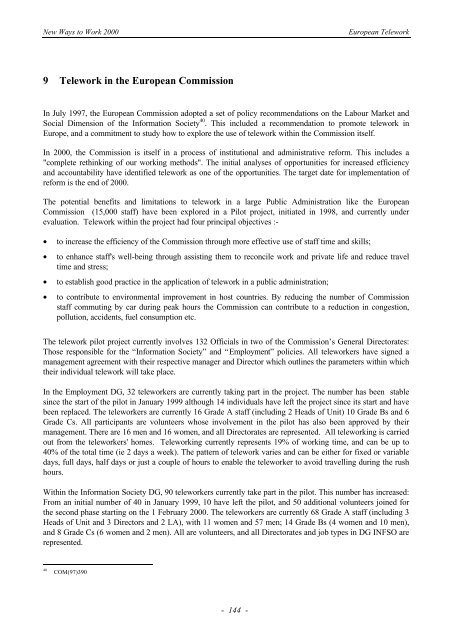eWORK 2000 - European Telework Week
eWORK 2000 - European Telework Week
eWORK 2000 - European Telework Week
- No tags were found...
You also want an ePaper? Increase the reach of your titles
YUMPU automatically turns print PDFs into web optimized ePapers that Google loves.
New Ways to Work <strong>2000</strong><strong>European</strong> <strong>Telework</strong>9 <strong>Telework</strong> in the <strong>European</strong> CommissionIn July 1997, the <strong>European</strong> Commission adopted a set of policy recommendations on the Labour Market andSocial Dimension of the Information Society 40 . This included a recommendation to promote telework inEurope, and a commitment to study how to explore the use of telework within the Commission itself.In <strong>2000</strong>, the Commission is itself in a process of institutional and administrative reform. This includes a"complete rethinking of our working methods". The initial analyses of opportunities for increased efficiencyand accountability have identified telework as one of the opportunities. The target date for implementation ofreform is the end of <strong>2000</strong>.The potential benefits and limitations to telework in a large Public Administration like the <strong>European</strong>Commission (15,000 staff) have been explored in a Pilot project, initiated in 1998, and currently underevaluation. <strong>Telework</strong> within the project had four principal objectives :-• to increase the efficiency of the Commission through more effective use of staff time and skills;• to enhance staff's well-being through assisting them to reconcile work and private life and reduce traveltime and stress;• to establish good practice in the application of telework in a public administration;• to contribute to environmental improvement in host countries. By reducing the number of Commissionstaff commuting by car during peak hours the Commission can contribute to a reduction in congestion,pollution, accidents, fuel consumption etc.The telework pilot project currently involves 132 Officials in two of the Commission’s General Directorates:Those responsible for the “Information Society” and “Employment” policies. All teleworkers have signed amanagement agreement with their respective manager and Director which outlines the parameters within whichtheir individual telework will take place.In the Employment DG, 32 teleworkers are currently taking part in the project. The number has been stablesince the start of the pilot in January 1999 although 14 individuals have left the project since its start and havebeen replaced. The teleworkers are currently 16 Grade A staff (including 2 Heads of Unit) 10 Grade Bs and 6Grade Cs. All participants are volunteers whose involvement in the pilot has also been approved by theirmanagement. There are 16 men and 16 women, and all Directorates are represented. All teleworking is carriedout from the teleworkers' homes. <strong>Telework</strong>ing currently represents 19% of working time, and can be up to40% of the total time (ie 2 days a week). The pattern of telework varies and can be either for fixed or variabledays, full days, half days or just a couple of hours to enable the teleworker to avoid travelling during the rushhours.Within the Information Society DG, 90 teleworkers currently take part in the pilot. This number has increased:From an initial number of 40 in January 1999, 10 have left the pilot, and 50 additional volunteers joined forthe second phase starting on the 1 February <strong>2000</strong>. The teleworkers are currently 68 Grade A staff (including 3Heads of Unit and 3 Directors and 2 LA), with 11 women and 57 men; 14 Grade Bs (4 women and 10 men),and 8 Grade Cs (6 women and 2 men). All are volunteers, and all Directorates and job types in DG INFSO arerepresented.40COM(97)390- 144 -








